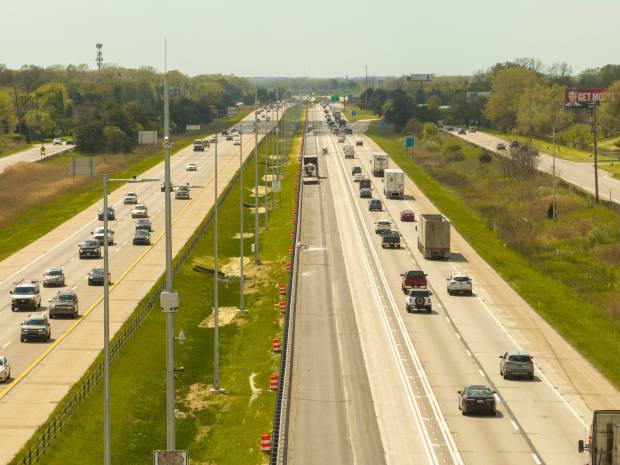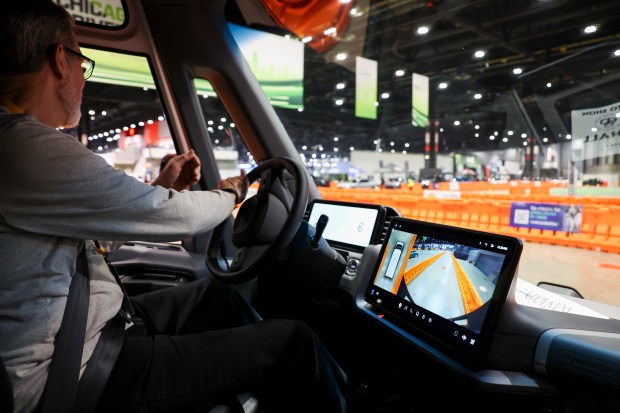DETROIT — Smart roads that enable vehicles to communicate with traffic infrastructure could help goods and people travel faster and be the key to unlocking innovation to help the United States compete with China, one Bank of America automotive analyst is suggesting.
Worries about China’s economic activity and research and development are rampant. President Donald Trump has raised national security concerns and imposed tariffs on the Asian nation, at least for now. U.S. automotive executives have expressed fears that their products can’t compete against the low-cost, digital-savvy offerings of Chinese manufacturers. China is rapidly achieving advancements in artificial intelligence, microchips and other breakthrough technologies.
Smart roads, argues John Murphy, the analyst, could do what automobiles and, particularly, their mass adoption from the assembly line did for economic activity in the early 20th Century. By creating more efficient traffic flows — from vehicles being able to communicate with each other and infrastructure like street lights to designated lanes for vehicles that could travel at higher speeds, and live information rerouting traffic when there’s an accident, construction or other congestion — people could travel longer distances in shorter amounts of time and improve productivity.
“When you look at what China has done over the last few decades, getting people into vehicles so they’re driving, they’re moving farther, faster and more frequently, that’s where you saw very significant economic growth in China,” Murphy told The Detroit News. “The more miles that are driven, the more things that are going on, and the more economic activity there is.”
The mass market for private automobiles in China grew starting in the late 20th century. By 2010, vehicle sales there surpassed those of the United States, making it the largest vehicle market globally. It was estimated there were 353 million registered vehicles in China at the end of 2024.
But a larger percentage of people in the United States still have vehicles compared to China. Last year, the country had 223 vehicles per 1,000 people. The United States had 860. Between 1990 and 2022, China averaged substantial economic growth of almost 9% per year, peaking at more than 14% in some years. The U.S. economy grew at 2.8% last year. China’s grew at 5%.
Christopher Tang, faculty director at the University of California, Los Angeles’ Center for Global Management, said China’s economy already was growing when vehicles sales began increasing, but it created a greater need for transportation, resulting in the country opening the way for Volkswagen AG and others that followed to partner with domestic manufacturers to build and sell vehicles in China.
“That’s why China was the biggest car market in the world at the time, because the economy is booming, and they need transportation,” he said during a recent National Press Foundation webinar. “They needed to get things moving.”
Innovation isn’t an easy concept to measure, but looking at patents, China is outpacing the rest of the world, said Marco Richter, senior director of intellectual property analytics and strategy for LexisNexis Intellectual Property Solutions. Over the past decade, 54% of active patents had an investor’s address listed in China.
Murphy asserts China’s growth in personal transportation accelerated the country’s economic activity. Meanwhile, here in the United States since the 1956 Federal-Aid Highway Act that created the interstate highway system, U.S. roads and how quickly Americans can travel on them has remained relatively stagnant, he said.
“The (automotive) industry has, in my opinion, a bit of an identity crisis, and is not understanding what its product actually is and the utility that it delivers to consumers,” Murphy said. “Its simple reason for being is to get people from A to B as quickly as possible, safely and cost effectively.”
He added: “We have stalled a key driver of our economy, and that’s people moving forward faster and more frequently.”
Internet-connected vehicle technology, advanced driver assistance systems and autonomous driving make this even more feasible, Murphy said. He outlined examples of a traffic light changing based on information sent from incoming traffic, a vehicle rerouting in anticipation of conditions ripe for an accident and designated high-speed expressway lanes that could allow travel of 100 mph or even 200 mph because of vehicles being able to communicate with each other and objects around them.
The result could be people spreading out more than they can today, potentially even paving the way for a heartland resurgence, Murphy said: “There’s plenty of land in the middle of this country that a lot of people don’t want to go to, because it’s hard to get to, but if it becomes a lot easier to get to, then that land starts to open up and become available to a lot more people.”
If there’s a particularly progressive governor or state leaders in this area, and it results in boosted economic activity, it could cause others to follow, Murphy said, adding that a vehicle that has offerings in this area also could be a differentiator and value creator for automakers.
“In reality right now, a Honda Accord versus a Mercedes S Class, they’re functionally the same product at the moment, because you get to the same place in the same amount of time,” Murphy said. “But if, for some reason, you buy a $100,000 or $150,000 car that can get you there twice as fast, you’re pretty happy to pay that money, or more people would be happy to pay that money, because it saves you time.”
This concept, however, could raise safety concerns. There were close to 40,000 traffic fatalities last year, a 3.8% decrease from 2023, according to the U.S. National Highway Traffic Safety Administration estimates. The rate, however, remains above pre-pandemic years. Speed is one contributor.
There are examples of connected vehicles, ADAS and other smart road technologies improving safety, said Mark Chung, executive vice president of safety leadership and advocacy at the National Safety Council, a nonprofit focused on supporting health and safety. But the deployment of autonomous vehicles on roads with human drivers can create scenarios a robot has never before seen, mandating extensive testing, he said.
Add on top of that higher speeds, and the technology just isn’t there yet, Chung said. The largest automotive lobby group is suing the U.S. Transportation Department over requirements on automatic emergency braking, arguing they’re too stringent for the state of the technology to perform reliably at night and higher speeds.
“No matter how advanced the AI or the AVs are, and the communication networks are, these vehicles, and all of us humans in them, are bound to the fundamental laws of motion,” Chung said, “which basically says that the kinetic energy that is generated through speed — a vehicle traveling 100 miles an hour as an example — if that vehicle crashes into something, it’s got four times the kinetic energy as one that is going at 50 miles an hour. The amount of energy that is required to then stop the vehicle, or maybe reorient the vehicle to maneuver it, it will take a tremendous amount of energy and technological progress for us to get there.”
He added: “If we think about a collision happening at 100 miles an hour, it will certainly be catastrophic.”
Murphy agreed that work would need to be done to make high-speed travel safe, from barriers for the lanes and advancements in technologies like emergency braking.
“There’s certainly reasons to be concerned with safety,” he said, “but you by no stretch of the imagination can say that we’re not going to do something because we’re only fearful of safety. You have to solve that safety issue, because otherwise you’re not advancing society.”
There are also other obstacles like costs, regulations, and the need to get many parties, from the auto industry to government agencies to technology companies, to work together. Additionally, related projects could require extensive work. A bold shot would be legislation similar to the 1956 Federal-Aid Highway Act, but for smart roads, Murphy said.
“It’s not really a moonshot,” he said. “It would be a terrestrial shot.”
Plus, the auto industry has low margins and is investing significant amounts already in electrification and other technologies. And limited range already is hampering the adoption of electric vehicles that U.S. automotive executives say are the future of the industry. Today’s EVs don’t have the capacity for long-distance, high-speed travel, unless there’s a breakthrough in that technology, Murphy said.
There, however, are pockets of examples in which companies and governments are seeking to leverage technology to facilitate safer, more efficient travel. Perhaps one of the most advanced examples is the Michigan Transportation Department’s collaboration with smart road startup Cavnue LLC.

Dubbed the “world’s most sophisticated roadway,” construction in 2023 began on a smart lane along a three-mile stretch of Interstate 94 in Wayne County from Haggerty to Rawsonville roads. It’s a pilot for a greater vision of a high-tech corridor from Ann Arbor to Detroit. Cavnue is paying for the pilot, which it estimated in 2023 to cost $10 million.
The left lane designated with a boundary separator for the other lanes is open and usable to the public except when MDOT, Cavnue and other partners like automakers and suppliers are using it for testing during off-peak times. Cavnue installed its smart road platform that includes cameras, sensors and other technologies to collect data on what is happening on the road.
MDOT is then looking at how it can use that information to communicate messages more quickly to motorists or vehicles themselves, like when there’s an accident, congestion or a wrong-way driver, which may cause them to go another way. The system could also help with maintenance in identifying potholes or other issues to be fixed more quickly.
“We are reviewing the data coming off of it,” said Michele Mueller, MDOT’s manager of connected, automated vehicles and electrification. “We’re evaluating what it is to determine where does it fit, where could it fit and what’s the value to us from what we have today.”
Particularly looking at automated driving, the system potentially could allow for smaller distances between vehicles that’s mandated in the vehicle code and increase capacity on roads or help determine whether lanes can be built at smaller widths than the current 12 feet, Mueller said.
The pilot successfully detected incidents and road hazards on I-94 during testing, Cavnue CEO Tyler Duvall said in an email. He said there’s enormous potential for the United States to lead in intelligent infrastructure right now.
“Cavnue absolutely shares John Murphy’s view that smart-road infrastructure is a strategic lever for economic growth, productivity, and competitiveness,” he wrote. “A connected, high-speed, digitally managed corridor network doesn’t just move vehicles more efficiently — it unlocks entirely new transportation models that can reduce congestion, improve safety, increase freight reliability, and expand economic growth.”
There isn’t a focus during the pilot on freight transportation, and vehicles like semitrucks don’t have access to the Cavnue lane at this point. But MDOT is having conversations with that industry as well as transit agencies about how to leverage the technology for their applications.
MDOT isn’t looking at adjusting the speed limit for the lane at this time either, but Mueller said down the line, perhaps that could be examined through the processes the department has in place for assessing whether to increase or decrease speed limits.
Duvall said he does see a future in which dedicated lanes for connected and autonomous vehicles can support higher-speed travel, but only when technology, the regulatory environment and human behavior align to support it.”Cavnue is actively exploring how infrastructure can safely support speed differentials through intelligent lane management, dynamic signage, and real-time feedback loops,” he wrote. “That said, higher speeds must always be balanced with safety and must evolve in step with government oversight and public confidence.”
Conversations between MDOT and Cavnue are also ongoing about a long-term agreement of probably around 10 years for the corridor, Mueller said, though nothing has been signed at this point. Eventually, motorists could have to pay a toll or user fee for it.




